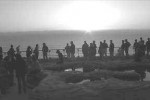With the new millennium, LTER faces new technological challenges-in identifying and developing appropriate technologies and in putting them to use. A newly formed LTER Technology Committee met recently to begin addressing these challenges.
The Committee discussed requirements for establishing a network of ecological observatories, as well as new issues surrounding information technology. The Committee also discussed potential funding opportunities, especially in regard to advanced computing, acquiring and processing new remote sensing data, and new methods for acquiring LTER site measurements.
It became immediately apparent that cooperation with the LTER Committees for Information Management and Climate, as well as the LTER Coordinating Committees is necessary because of overlaps in goals and requirements within each of these committees. While the Technology Committee concluded that work toward recommendations for the LTER Network depends on this cooperation, results of preliminary discussion are listed below. The Committee plans to meet again in early 2000 to formulate a more complete list of recommendations for LTER technological development.
The following is a summary of recommendations for computer technology, remote sensing data and LTER site field and laboratory measurements.
Computer Technology
The Technology Committee recommended that the original definition of the LTER site Minimum Standard Installation should be viewed in light of the rapid pace of technological change. The "server" component should be considered within the context of current, 500mhz multiple processors, and online archival storage in the range of 1 terabyte to encourage online data storage including video, GIS and remote sensing imagery. Software components should include current database technologies for data search and retrieval.
Geographic Information System and related components should include remote sensing tools for advance image processing related to high spatial (1m) and high spectral resolution (>200 waveband) data as well as advance visualization and modeling tools. Video conf-erencing, and general data communication technologies (whiteboard and presentation software) should be more widely used across the LTER Network for conferencing and remote meeting access. Network connections at field sites and home institutions should include uses where applicable, of wireless technology, T1 and very high performance Backbone Network Service (vBNS) Internet connections. LTER should also make better use of high performance computer installations through collaborations like those developing between LTER and the San Diego Supercomputer center for large-scale data storage, modeling and visualization.
Remote Sensing Data
The primary recommendation related to LTER remote sensing technology was to take advantage of the vast array of remote sensing technology related to the NASA/EOS "TERRA"-platform launch and other remote sensing data sources. With the successful launch of Landsat 7 on 15 April 1999 and its relatively inexpensive data, the LTER Network should coordinate efforts with NASA to fulfill recommendations of previous committees for Landsat data acquisition of all LTER sites on at least an annual basis.
LTER Site and Field Measurements
The committee recommended that the LTER Network should apply tools for the automation of site measurements wherever possible. The committee thought LTER should make more use of portable computer technology for field notes, real-time data communications and datalogging systems with automated data transmission packages using spread-spectrum wireless, cellular digital packet data (CDPD) data or other technologies for communication and transmission of data. Automated measurements should make use of robotic packages for observations beyond conventional systems, including small scale tunneling systems, night observation video, and small scale aerial observation systems. The LTER Network should make better use of miniaturized technology such as micro-sensor systems—so called "laboratories on a chip" for both field and laboratory measurements.
Field measurements could include automated camera systems and small-package GPS systems for animal observation and tracking. Standardized genetic mapping tools for species identification, with long-term sample preservation and storage, should be implemented across the LTER Network.
For applications related to an ecological observatory network, science platform tower installations should be installed as an augmentation of the more conventional LTER meteorological site installations. Such installations could include use of automated observations systems including both video and audio technologies for recording site characteristics, monitor plot growth studies, and to record insect and animal species characteristics. Standard "WebCam" technologies should also be applied to LTER site observations and experiments.
A complete report from the Technology Committee Meeting is available through the Technology section of the main LTER web page at http://www.lternet.edu.
Technology and LTER: A New Era
By:
John Vande Castle (LNO) 
 Enlarge this image
Enlarge this image